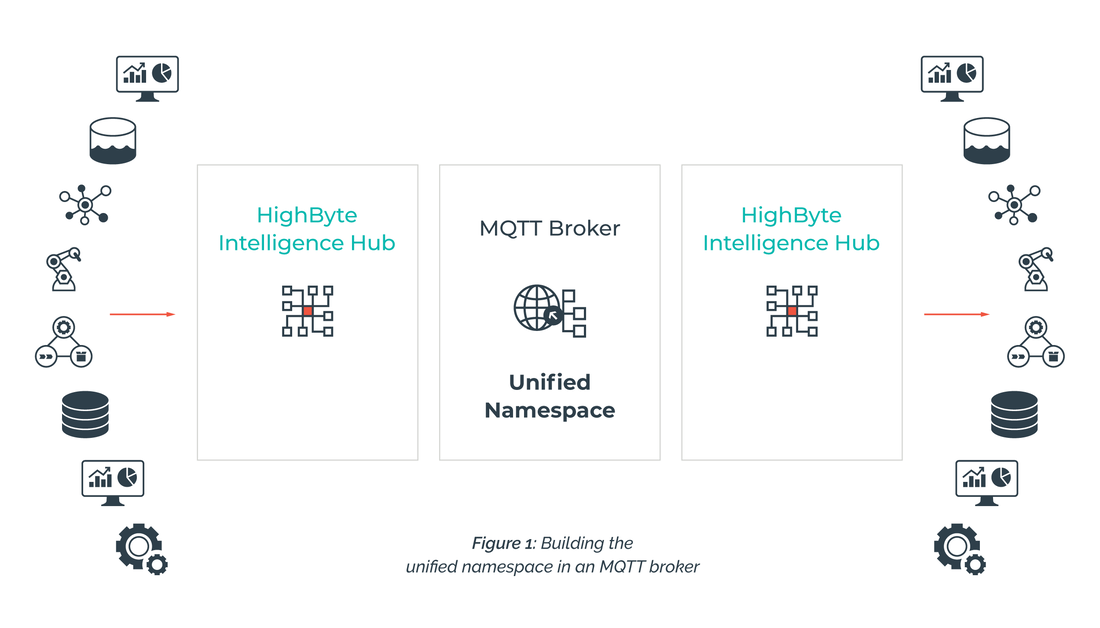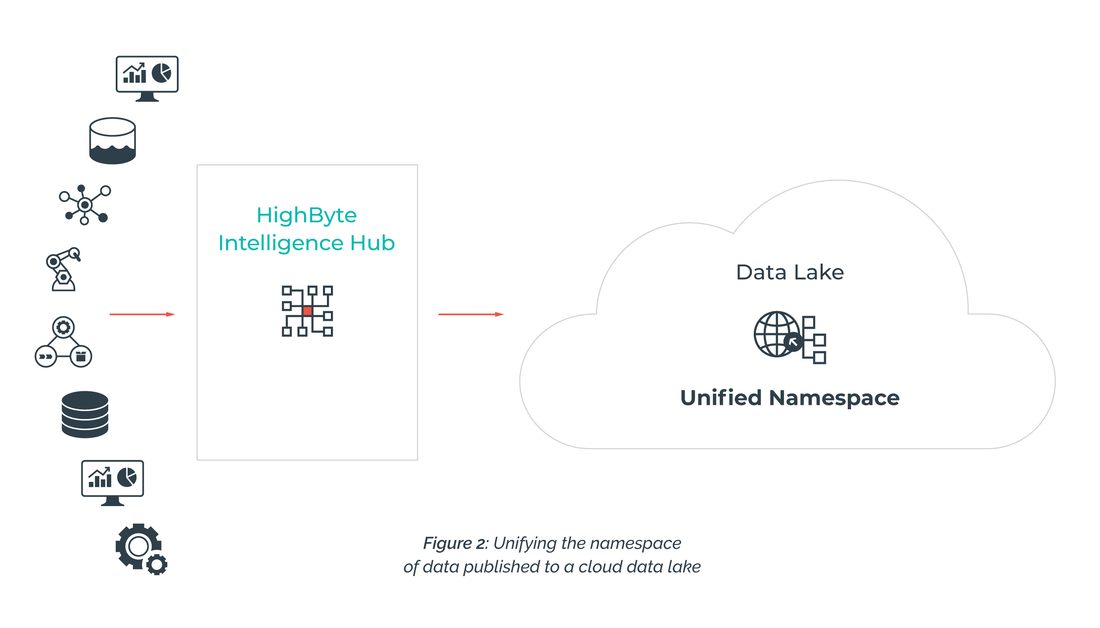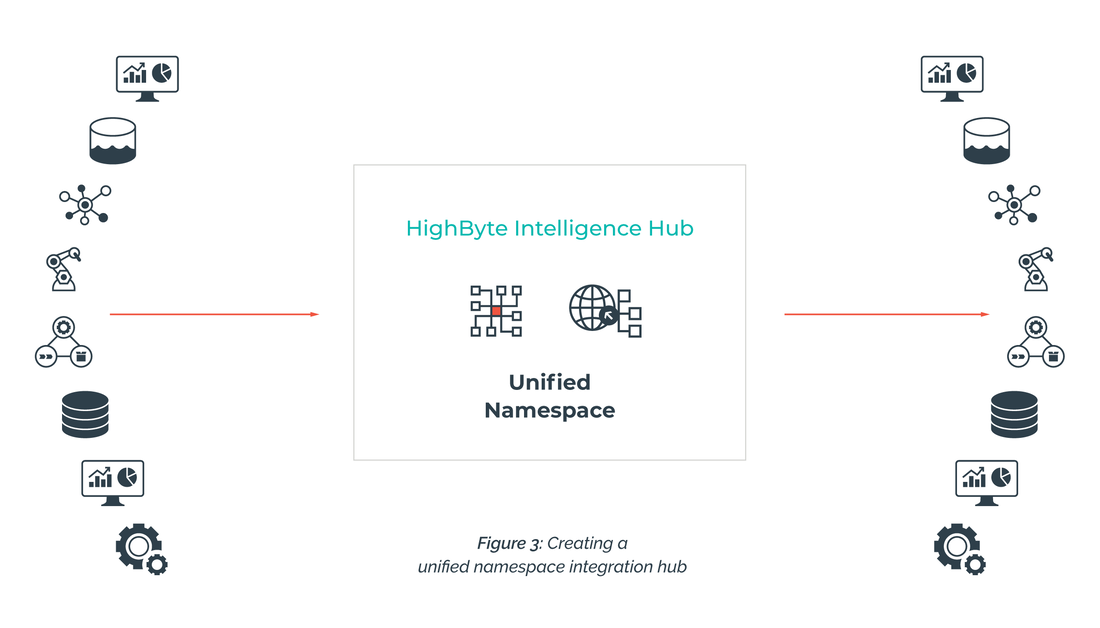Is HighByte Intelligence Hub a unified namespace?

John Harrington
is the Chief Product Officer of HighByte, focused on defining the company’s business and product strategy. His areas of responsibility include product management, customer success, partner success, and go-to-market strategy.
Update: HighByte Intelligence Hub has evolved since this blog first published in July 2021. Please visit this post to learn how the Intelligence Hub now provides a complete UNS infrastructure solution.
The unified namespace (sometimes referred to as the UNS or universal namespace) can be an allusive concept for many of us as we move to an Industry 4.0. world. At HighByte, we define the UNS as a consolidated, abstracted structure by which all business applications are able to consume real-time industrial data in a consistent manner. The benefits of a UNS include reduced time to implement new integrations, reduced efforts to maintain data integrations, improved agility of integrations, access to new data, and improved data quality and security.
We are often asked if HighByte Intelligence Hub is a UNS. The answer depends on your priorities and project scope. We typically see three architectural patterns for implementing the UNS. HighByte Intelligence Hub can play a key role in each approach by both providing access and structure to the UNS or acting as the UNS.
We are often asked if HighByte Intelligence Hub is a UNS. The answer depends on your priorities and project scope. We typically see three architectural patterns for implementing the UNS. HighByte Intelligence Hub can play a key role in each approach by both providing access and structure to the UNS or acting as the UNS.
Option 1: Building the unified namespace in an MQTT broker
The most frequently deployed unified namespace architecture is building the UNS in an MQTT broker. Data is published to the UNS from multiple systems into a topic structure in the MQTT broker typically following the ISA-95 structure of company, site, area, line, workcell, asset. With the MQTT broker, all systems publish data when they have a change to be integrated. The consuming systems subscribe to relevant data and receive updates from the broker when updates occur.
The advantages of the MQTT broker UNS architecture include open accessibility, self-service access to the data, and a structured organization of the varied published data. The challenges of the MQTT broker UNS architecture include the need to logically structure the topic namespace with relevant data payloads and the lack of MQTT support for all publishing and subscribing applications. However, these challenges are solved by combining the MQTT broker UNS architecture with HighByte Intelligence Hub. When combined, these technologies deliver a complete, easy to deploy, accessible, and structured solution. The Intelligence Hub can consume data from multiple sources, assemble the data into logical payloads that follow ISA-95 structures or other company or industry standards, and publish the payload to the UNS. The Intelligence Hub can also be used to subscribe to data in the UNS and then publish it to systems that have REST APIs, SQL databases, or OPC namespaces and don’t communicate over MQTT. In this way, HighByte Intelligence Hub acts as the gateway to the UNS and effectively surrounds the broker.
The advantages of the MQTT broker UNS architecture include open accessibility, self-service access to the data, and a structured organization of the varied published data. The challenges of the MQTT broker UNS architecture include the need to logically structure the topic namespace with relevant data payloads and the lack of MQTT support for all publishing and subscribing applications. However, these challenges are solved by combining the MQTT broker UNS architecture with HighByte Intelligence Hub. When combined, these technologies deliver a complete, easy to deploy, accessible, and structured solution. The Intelligence Hub can consume data from multiple sources, assemble the data into logical payloads that follow ISA-95 structures or other company or industry standards, and publish the payload to the UNS. The Intelligence Hub can also be used to subscribe to data in the UNS and then publish it to systems that have REST APIs, SQL databases, or OPC namespaces and don’t communicate over MQTT. In this way, HighByte Intelligence Hub acts as the gateway to the UNS and effectively surrounds the broker.
Option 2: Unifying the namespace of data published to a cloud data lake
Some system architects do not need to rearchitect the integrations of their existing systems and prefer to leave operational integrations in place; however, they want to send industrial data to a cloud data lake for analytics and operational visibility. In this case, they need to unify the namespace of data published to the Cloud such that it is standardized, contextualized, and organized in a manner they can rapidly utilize.
There are several challenges when having all systems publish directly to the Cloud. For example, many of the integration capabilities in these systems do not exist or are not optimized for the Cloud and the standardized objects needed in the cloud often require real-time data from one system and contextualization information from another system. There is no easy way to standardize the data from a single site, let alone across multiple sites in an enterprise. HighByte Intelligence Hub provides a perfect gateway for this type of UNS. Models in the Intelligence Hub consolidate and standardize data into contextualized information objects, while flows in the Intelligence Hub target data to the specific location in the data lake or cloud broker where they are needed.
There are several challenges when having all systems publish directly to the Cloud. For example, many of the integration capabilities in these systems do not exist or are not optimized for the Cloud and the standardized objects needed in the cloud often require real-time data from one system and contextualization information from another system. There is no easy way to standardize the data from a single site, let alone across multiple sites in an enterprise. HighByte Intelligence Hub provides a perfect gateway for this type of UNS. Models in the Intelligence Hub consolidate and standardize data into contextualized information objects, while flows in the Intelligence Hub target data to the specific location in the data lake or cloud broker where they are needed.
Option 3: Creating a unified namespace integration hub
The final UNS architecture, a unified namespace integration hub, is used when the primary focus is integrating multiple systems faster and more efficiently. A hub and spoke integration approach requires unifying the namespace based on the target application. This approach is focused more on integrating systems and not on creating a central open broker for all to browse and subscribe to the data. This solution requires an information hub that can communicate over open integration protocols and APIs and can provide a scalable and repeatable approach to standardizing data as it’s transferred from one system to another. In this case, HighByte Intelligence Hub is the unified namespace integration hub. The Intelligence Hub makes connections to source systems, ingests the data, and standardizes and contextualizes the data into information objects specifically designed for the consuming application such that the object can be directly ingested. The Intelligence Hub provides a code-free UI, eliminating the need for custom coded integrations or additional data transformations and dramatically reducing the maintenance of integrations. By unifying the integrations into a single application designed for the Operations Technology team, the hub can be rapidly deployed and efficiently managed by the team who understands the source data and the changes that occur to operational systems over time.
The path you choose really depends on your own unique architecture, requirements, and corporate preferences.
The path you choose really depends on your own unique architecture, requirements, and corporate preferences.
Learn more
If you would like to learn more, watch this this short video to see my colleague Aron Semle demonstrate how to push SQL data to a unified namespace (in this case, an MQTT broker).
When you’re ready to try HighByte Intelligence Hub for yourself, come join our free trial program that provides access to the latest release, product resources, and a HighByte team member to help guide you through your evaluation.
When you’re ready to try HighByte Intelligence Hub for yourself, come join our free trial program that provides access to the latest release, product resources, and a HighByte team member to help guide you through your evaluation.
Get started today!
Join the free trial program to get hands-on access to all the features and functionality within HighByte Intelligence Hub and start testing the software in your unique environment.


